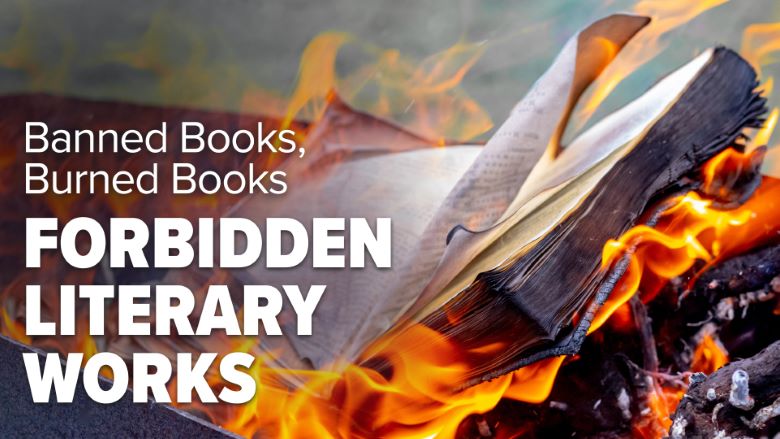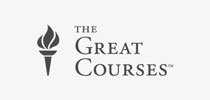The written word has amazing power. It can open your eyes to new ideas and allow you to view the world through different perspectives. It can create pathways of communication, pass down cultural knowledge, and connect disparate peoples and beliefs. Some books have even changed the world. This power is often why literacy is so strongly centered in cultures across the globe. It is also why some books are seen as a threat that must be contained or eliminated.
In Banned Books, Burned Books: Forbidden Literary Works, you will consider some of the so-called greatest works of literature ever written in English and some literature that’s considered … not so great. What all these works have in common is that someone—a judge, a vocal parent, a government official, or a powerful librarian or a group of “someones” like a library board, PTA, or school board—thought every one of these works was dangerous enough to challenge, or ban, or even burn.
Throughout these 24 lectures, author and book critic Professor Maureen Corrigan of Georgetown University will take you on a tour of some of the most challenged and controversial works of literature, from the plays of Shakespeare to 21st-century best-sellers—even including the dictionary and classic fairy tales. You will trace the history, in the United States and Great Britain, of the challenges to books, the censoring of books, book bans, and even burnings. You will explore the common reasons books have been and continue to be banned, including profanity, heresy, illicit or sexual content, racism, violence, and more. And you’ll consider the shifting trends in why books are challenged.
Books wouldn’t be a target of censorship and banning if they weren’t so powerful, right? Ironically, as you’ll see throughout these lectures, sometimes the best way to publicize a book, increasing both its audience and securing its legacy, is to attempt to ban it.
Moral Misgivings and Contested Classics
Attempts at censorship have existed since the printing press made books and printed materials widely available in the 15th century. While headlines about book banning today are often centered on works within a school system or a local library, some books have been found so troubling or offensive they were put on trial for obscenity or outright banned at the national level. These legal battles and bans often had long-lasting repercussions for the concept of free speech. Some of these works include:
- Ulysses by James Joyce was published in book form in 1922. It was promptly banned as obscene throughout most of the English-speaking world, for over a decade, before it was tried (and appealed) in court.
- Lady Chatterley’s Lover by D. H. Lawrence was published in 1929. Lawrence’s frank depictions of sexuality caused trouble for him throughout his career, but this novel was especially controversial and was heavily censored for decades and finally put on trial in the 1950s.
- “Howl” by Allen Ginsberg was published with several other poems by Ginsberg in a small booklet in 1956. Later called “the poem that would change America,” “Howl” resulted in its publisher being charged with obscenity in 1957, and the trial made Ginsberg into a literary celebrity.
- Lolita by Vladimir Nabokov was first published in 1955 and was banned in numerous countries due to its disturbing subject matter. However, it became an instant best-seller in the United States thanks to the controversy it stirred up. It continues to be one of the most challenged and banned books today.
- Forever by Judy Blume was published in 1975. Though it never went to trial for obscenity, this classic of young adult (YA) literature has been consistently challenged over the years for its frank discussion of sexuality. And, it isn’t the only title of Blume’s to receive this treatment. She is considered one of the most challenged and banned authors in the United States.
Many of these works went on to be considered literary classics and are often taught as part of college English classes. A rise in popularity following public attempts at censorship is actually quite common, as you will see in reactions to the Harry Potter book series and Salman Rushdie’s novel The Satanic Verses.
While you will meet many authors who took a stand against censorship, such as Thomas Morton—the author of America’s first banned book and a symbol of early American resistance to the religious and political status quo—you will also be introduced to a number of authors and creators who have altered or destroyed their own work. In some cases, as Maureen highlights, this desire to make their own work disappear comes out of a sense of shame or frustration, but sometimes these texts are destroyed by concerned friends and family after an author’s death.
Protecting the Children?
One of the primary reasons given for censoring literature is, in the words of 19th-century purity crusader Anthony Comstock, “to protect the youth.” So, it should come as little surprise that books written for children and young adults are some of the most challenged, censored, and banned books in the United States and Great Britain.
Common wisdom—indeed, common sense—holds that malleable young minds should be protected from material that’s age inappropriate—sexually or otherwise. But the question of which narratives and images fall into that category of “inappropriate” has been the focus of fierce controversy, as well as more than a few moments of absurdity. To cover even a little of the rich and complex history of challenging children’s literature, Maureen focuses three lectures exclusively on kid’s stories and touches on many time periods and genres, from classic fairy tales to surrealist Victorian adventures to graphic novels featuring an underwear-clad superhero.
Along the way, you will also see how books that have been widely accepted as part of school English literature programs—works like The Catcher in the Rye, Adventures of Huckleberry Finn, and To Kill a Mockingbird, among others—continue to also find their way onto lists of challenged and banned books. Likewise, you will see how the battles over the “great American novel” are part of a larger conflict over what is representative of the nation and its pluralistic roots.
What’s Old Is New Again
The challenging, censorship, and even destruction of works found to be offensive or threatening to the status quo is not new, but the nature of 21st-century communication and politics has certainly influenced the way books are evaluated and judged today. The rise of social media has blurred the line between an author’s work and their private life, while it has also given readers and would-be critics a platform to make their voices heard. And social justice movements have brought race, sexual identity, and other issues to the forefront of the consideration of literature and its influence on culture.
These new elements certainly influence how we approach censorship now, and yet many of the complaints brought against books today are not so different from the criticism of a century (or several) earlier. And the taboo and forbidden nature of banned books has its own special appeal for the human psyche as well, making literary censorship an especially complicated and fascinating subject. As you consider the broader history of book censorship, you will hopefully find yourself thinking more rigorously about your own views on intellectual freedom and the right to read.
01 Bowdlerizing the Bard
02 Ulysses on Trial
03 The Defense for Lady Chatterleys Lover
04 Censors from the Inquisition to the Puritans
05 Anthony Comstocks Moral Crusade
06 Books on Fire The Reformation to Rushdie
07 Allen Ginsbergs Alarming Howl
08 Holden Caulfields Subversive Voice
09 Artistry, Morality, and Nabokovs Lolita
10 Authors Who Censor Themselves
11 The Hidden Dangers of Fairy Tales
12 Contested Classics of Childrens Literature
13 New Kids Books, Old Objections
14 Canceled Authors
15 Huckleberry Finn and Race in America
16 To Kill a Mockingbird, Then and Now
17 Young Adult Fiction and Its Discontents
18 Attempts to Suppress #MeToo Books
19 The Battle over Critical Race Theory
20 Alice Walker and Toni Morrison under Attack
21 The Textbook Wars
22 The Backlash against Harry Potter
23 Fun Home An All-Too-Graphic Memoir
24 Contesting the Great American Novel
Trailer



